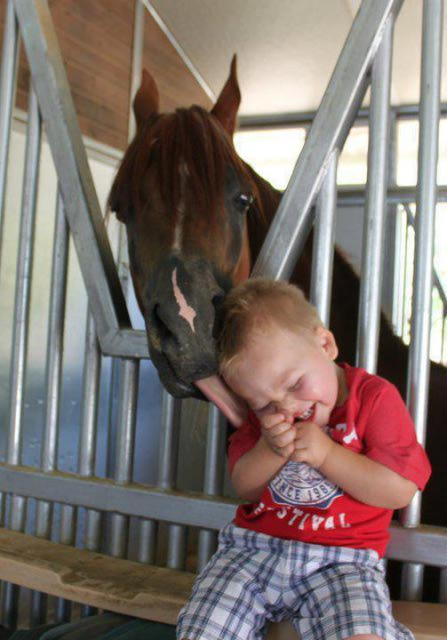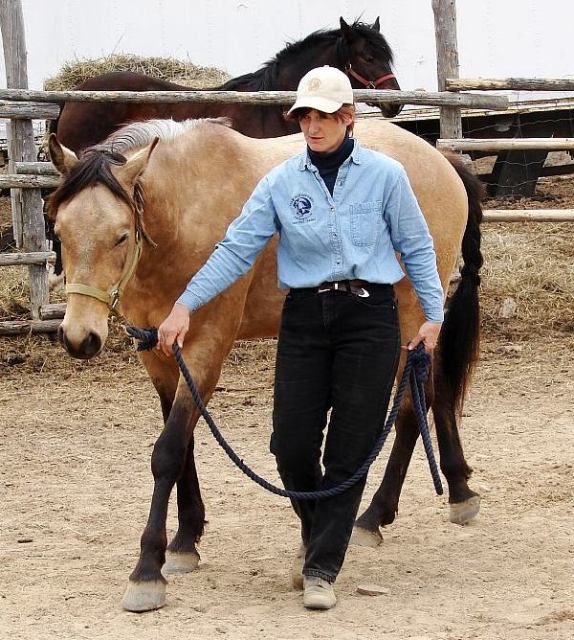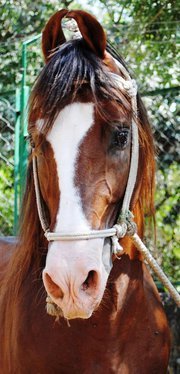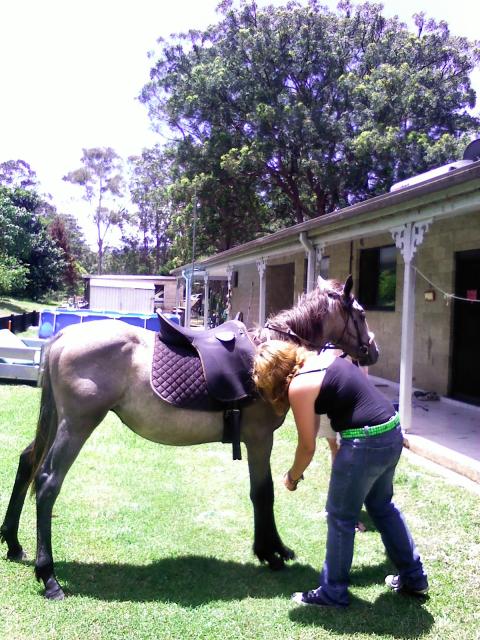QuestionI have a 3 year old filly, 175cms to the withers, who i have left at grass until now she has had a halter on and leads fine, however when i tie her up after a short while she gets tierd of being tied up and pulls and pulls until she breaks halter/lead/or bends clips ect, i have tried a thick chain instead of a lead and this is the same, she bends the clips, he only way to stop her is to stand behind her and frighten her with something. please tell me what can i do....
AnswerHi Natalie. I recently responded to a gentleman's question that was very similiar to yours and my response was this:
Your horse has NOT been properly halterbroke. She has not been taught to give to pressure in all 6 directions, at different amounts of pressure 100% of the time. If she was, she would have no problem standing tied. A horse that is properly halterbroke will never pull against pressure on his halter, even when startled.
I have outlined 2 exercises below that you can use to test your horse. If you answer 'yes' to any of the exercises below, you must re-train your horse to be properly halterbroke.
1. This exercise is designed to tell you whether your horse has been trained to give to pressure on the top of his head. (This is the area that pressure is applied to when a horse is pulling back on the cross-ties). Hold your horse's lead rope about 4 inches from his chin, and apply even pressure straight down (towards the ground). Does she raise her head or pull back at first, or do nothing at all? If yes, she's not properly halterbroke. If no, continue to step 2.
2. This exercise is similar to the one above, but it will also tell you whether or not your horse will give to pressure when she is startled or surprised. Hold your horse's lead rope about 4 inches from his chin, and apply a quick, steady pressure downwards. This pressure should be fairly hard. Does she raise his head or pull back at first, or do nothing at all? If he gives to pressure and lowers her head, continue to step 3.
3. Repeat steps 1 and 2, but with pressure pulling forward on the halter. If she easily gives to the pressure, then continue to step 4.
4. Repeat steps 1 and 2, but with pressure pulling backward (toward the horse's chest) on the halter. If she easily gives to the pressure, then she should be fine to put on the cross-ties.
Repeat these exercises in every direction: left, right, forward, back, up and down. If, at any time your horse becomes uneasy, raises her head, pulls back or rears, you must go back to halterbreaking basics.
In addition to the exercises above, you'll need to "sack-out" your horse. Your horse will need to be consistent with giving to pressure on the halter even when there are distractions. Start in a calm, quiet environment when beginning to teach your horse to give to pressure. Once she is 100% consistent, begin to slowly introduce distractions. The distractions you introduce should challenge your horse's sight and hearing, but should not be so distracting that she no longer listens correctly to your requests on the halter. Try adding a dog in the aisle, or people and other horses walking past you. Ask a friend to stand at a comfortable distance and make strange or loud noises. Never increase the distraction level past your horse's comfort zone. Wait until she is 100% comfortable with the current level of distraction before you increase the distractions. Soon, you'll have a horse who gives to pressure on the halter 100% consistently even when she is in a very distracting environment.
Always remember that a horse if he or she has been PROPERLY halterbroke will NEVER pull against pressure on the halter.
Good luck to you Natalie!

 K K snaffle
Question
K K snaffle
hello, what are K K snaffles? is i
K K snaffle
Question
K K snaffle
hello, what are K K snaffles? is i
 licking palm or face
Question
licking
hello maam, what does it mean i
licking palm or face
Question
licking
hello maam, what does it mean i
 Arabian Mare
QuestionI have had a large dog coming onto my property
Arabian Mare
QuestionI have had a large dog coming onto my property
 veins coming out on horse face
Question
veins coming out on ho
hello maam, this is a k
veins coming out on horse face
Question
veins coming out on ho
hello maam, this is a k
 Breaking in and bad habbits
Question
Jasper- saddled
Hi, im 17 years old.i have a 2
Breaking in and bad habbits
Question
Jasper- saddled
Hi, im 17 years old.i have a 2